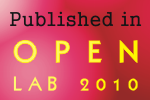This is the third post in a series about the science and societal impacts of the flu and flu vaccination. Specifically, I emphasize the importance of sound scientific literacy in understanding this important topic. Please read the first posts in the series if you missed them.
Part 1: Is the Swine Flu Vaccine Safe?
Part 2: Should I get the shot?
"I'll just take vitamins and natural herbs and I'll be protected from the Swine Flu."
Getting more Vitamin D
Particular to the Swine Flu, some people are recommending Vitamin D as a preventative to the disease. How does this work? Vitamin D is found in dairy and fish foods but our bodies are also able to manufacture Vitamin D if it sufficiently exposed to UV-B sun rays. Vitamin D is key for calcium and phosphorus uptake to keep your bones strong. Now there is some interesting research suggesting that Vitamin D might also be key in your immune response.
Vitamin D seems to be an important modulator in both your Primary and Secondary immune response. (See post 2 in the series where I define the immune response and immune cells) . A variant of the Vitamin D is apart of the molecular structure of some immune cells - like phages and B & T Memory cells. Without Vitamin D in the immune cells don't function to full capacity, have problem recognizing germs and don't attack and kill germs fast enough. The most compelling evidence shows that people who are deficient in Vitamin D are more likely to get sick from the flu, tuberculosis and suffer complications from Multiple sclerosis. This new research provides some very exciting news about how being adequately nourished is so important to maintaining good health.
What about eating organic foods?
Organic foods are delicious, and if you can afford to eat them then do. However, there is no evidence to suggest they are more or less healthy than traditionally raised and harvested foods. Eating fresher fruits, veggies, and whole grains is better for your general health than not eating fruits and veggies at all or eating processed foods. These foods provide vitamins and essential elements used by your immune cells to fight germs.
But I would like to make it clear, there is no evidence that Vitamin D or simply eating healthier foods alone are effective at preventative against any disease, including the Swine Flu. Simply, the results of the Vitamin D study and the benefits of eating organic foods reinforce the importance of a healthy, well-balanced diet. Eating well means getting all the nutrition you need to keep your body and your immune cells in tip-top shape.
Can't I just take care of myself in more natural/less invasive ways to avoid the Swine Flu?
The short answer is yes. Eating healthy, taking vitamins, getting some sunshine, exercise, a good night's sleep are perfect for keeping your body in its best condition to fight off any germ. Plus, nothing beats hand washing (but not with anti-bacterial soap) and sanitizing your home for killing germs and preventing exposure. And if you do get sick, then the routine regiment of rest, fluids, vitamins, seeing the doctor, and taking the prescribed medicine does the job. These are general precautions to any disease.
However, public health officials are adding an extra precaution this season because of the Swine Flu and here is why.
1. The Swine Flu is widespread and pervasive. It's only late October - still 2 months away from the peak flu season - and cases are a popping up everywhere. This is very odd, most seasonal flus don't show up so early and spread so quickly.

2. The Swine Flu doesn't pick on the usual suspects. This strange diseases is dealing its worst hand to teens and young adults. Typically, these are the healthiest people in the population and always the group people worry the least about when every pandemics come around. But the reports all indicate that these people are getting sick more. Most diseases pick on the weak -from an immune system perspective, this means the elderly, the very young, and people who are chronically sick - like cancer, diabetes, asthma, and heart disease . Their immune system is either slow or still too new to respond to serious germ, so swine flu could really do some harm to such people. 
That's why the doctors and public health officials recommend vaccination for the most at-risk groups: babies, toddlers, mommies (including pregnant women), the chronically ill, and young people (25 and younger). It seems the elderly have some immunity to swine flu due to previous exposure to the germ in the 1950s. But that still leaves a large number of people in the middle. If you are like me between the ages of 30-55, and in relative good health, you might not need the shot; and if you get the flu the odds are you will come through it just fine. However, you might want to get the vaccination to protect your family, especially if you spend time with anyone from one of the risk-prone groups listed above.
So, yes it is okay to wash your hands religiously, sanitize your home, school, and office space, cover your mouth and nose when coughing or sneezing, eat lots of fresh fruits and veggies, and take vitamins. But I still encourage you to seriously consider the Seasonal and Swine Flu vaccination for your family.
References:
Vitamin D, Wikipedia
Swine Flu Hospitalizing Mostly Young People In The US, Medical News Today October 2009
Organic food is no healthier, study finds, Reuters July 2009
AP Photo/The Post and Courier, Alan Hawes
CDC 2009 H1N1 Flu US Situation Update, October 23, 2009





















 Checking my bag. I caught something.
Checking my bag. I caught something.



 I caught a
I caught a 






































